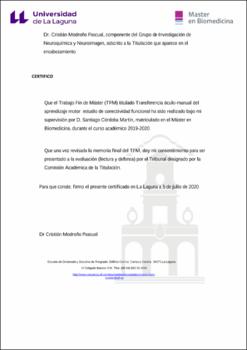Transferencia óculo-manual del aprendizaje motor: estudio de conectividad funcional
Autor
Córdoba Martín, SantiagoFecha
2021Resumen
Introducción: La transferencia motora es la aplicación de una habilidad motora aprendida en un
nuevo contexto. Algunos trabajos han estudiado las bases neuronales de este tipo de
trasferencia, pero no se han centrado en la conectividad funcional subyacente.
Objetivos: Estudiar la conectividad funcional subyacente a la transferencia motora ojo-mano.
Materiales y métodos: Participaron 32 voluntarios sanos divididos en un grupo experimental y
control. En un escáner de MRI realizaron una tarea de seguimiento donde perseguían un círculo
moviendo un joystick con la mano derecha antes y después de cinco días de entrenamiento en
la misma tarea, pero controlada con movimientos oculares.
Resultados: Tras el entrenamiento ocular observamos mejoras en la ejecución manual de la
tarea (transferencia motora). Independientemente del entrenamiento, durante la tarea manual se
observan correlaciones entre ROIs (regiones de interés) en áreas motoras (corteza motora
primaria, somatosensorial, cerebelo y putamen) y numerosos vóxeles del cerebro. También se
observan conexiones entre la corteza motora primaria y otras ROIs corticales (corteza
somatosensorial) y subcorticales (cerebelo y putamen). Además, se observan variaciones de
conectividad funcional en áreas motoras y somatosensoriales asociadas al entrenamiento ocular.
Conclusiones: Las tareas de seguimiento son sustentadas por conexiones funcionales entre la
corteza motora primaria y otras áreas motoras y somatosensoriales. La transferencia motora del
ojo a la mano se relaciona con cambios en las conexiones funcionales entre regiones motoras
corticales y subcorticales (cerebelo, somatosensorial, ganglios basales). Introduction: Motor transfer is the application of a motor skill learned in a new context. Some
works have studied the neural bases of this type of transfer but have not focused on the
underlying functional connectivity.
Objectives: Study the functional connectivity underlying eye-hand motor transfer.
Materials and methods: 32 healthy volunteers participated, divided into an experimental and
control group. In an MRI scanner they performed a tracking task where they chased a circle by
moving a joystick with their right hand before and after five days of training in the same task
but controlled with eye movements.
Results: Improvements are observed in the execution of the task after training (motor transfer).
Regardless of training, correlations are observed between selected ROIs (regions of interest) in
motor areas (primary motor cortex, somatosensory cortex, cerebellum, and putamen) and
numerous voxels in brain. Specific connections between the primary motor cortex and other
cortical motor ROIs (somatosensory cortex) and subcortical (cerebellum and putamen) are
shown. Furthermore, variations in functional connectivity are observed in motor and
somatosensory areas associated with ocular training.
Conclusions: Tracking task are supported by functional connections between the primary motor
cortex and motor and somatosensory areas. Motor transfer from the eye to the hand is associated
with changes in functional connections between cortical and subcortical motor regions
(cerebellum, somatosensory, basal ganglia)




